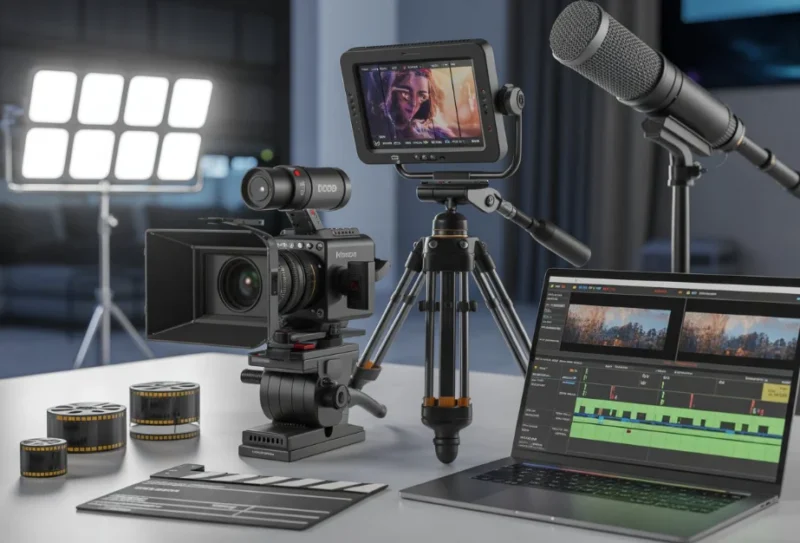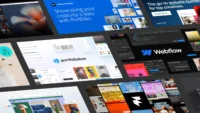In this article:
Making a great film today requires more than just a good camera and creative vision. Advanced filmmaking tools now combine traditional software with AI-powered features that can handle everything from script analysis to automated editing, giving filmmakers the power to compete with major studios. The landscape has changed dramatically, with independent creators now having access to professional-grade technology that was once reserved for big-budget productions.
I’ve seen how the right combination of advanced tools can transform a filmmaker’s workflow and final output. Modern filmmaking software goes beyond basic editing to include sophisticated color grading, motion graphics, and sound design capabilities. Meanwhile, AI tools are reshaping how we approach pre-production planning, post-production efficiency, and even content distribution.
The key is understanding which advanced tools will actually improve your specific filmmaking process without overwhelming your budget or workflow. From industry-standard software that handles complex visual effects to innovative platforms like LTXV that streamline production workflows, I’ll walk you through the essential advanced tools and techniques that can elevate your filmmaking to the next level.
Core Advanced Filmmaking Tools and Software
Professional filmmaking relies on specialized software for video editing, color grading, post-production effects, and audio engineering. These tools form the backbone of modern film production workflows.
Video Editing and Color Grading Solutions
LTX Studio (LTXS) combines AI-driven storytelling with cinematic precision, turning scripts into fully produced video scenes complete with characters, lighting, and camera motion. Its intuitive interface streamlines pre-visualization and production, making it ideal for filmmakers and marketers seeking to create professional, story-led videos effortlessly.
Adobe Premiere Pro remains my go-to choice for professional video editing. It handles 4K and 8K footage smoothly and integrates seamlessly with other Adobe products.
DaVinci Resolve offers the best color grading tools in the industry. The free version includes professional-grade features that rival expensive alternatives.

Get 300+ Fonts for FREE
Enter your email to download our 100% free "Font Lover's Bundle". For commercial & personal use. No royalties. No fees. No attribution. 100% free to use anywhere.
Final Cut Pro provides excellent performance on Mac systems. Its magnetic timeline makes complex edits faster and more intuitive.
For mobile editing, LumaFusion delivers desktop-quality results on iPads. I use it for quick cuts and on-location editing.
Color grading requires specialized tools beyond basic editing software. DaVinci Resolve’s color wheels and curves give me precise control over every frame. The software includes HDR support and advanced masking tools.
Professional editors often switch between multiple programs. Premiere Pro excels at timeline editing while DaVinci Resolve handles color work better.
Post-Production and Visual Effects Platforms
Adobe After Effects dominates motion graphics and compositing work. I use it for title sequences, visual effects, and complex animations.
Nuke represents the industry standard for high-end VFX work. Major studios rely on its node-based compositing system for feature films.
Blender offers complete 3D modeling and animation capabilities for free. Its Cycles render engine produces film-quality results without licensing costs.
Visual effects software requires different approaches than editing programs. After Effects uses layer-based compositing that feels familiar to Photoshop users. Nuke’s node system offers more flexibility for complex shots.
Blender handles everything from 3D modeling to final rendering. I use it for creating digital environments and character animation. The software includes sculpting tools, particle systems, and fluid simulation.
Motion graphics work often combines multiple programs. I create 3D elements in Blender, composite in After Effects, and finish in Premiere Pro.
Audio Editing and Mixing Applications
Pro Tools sets the standard for professional audio post-production. Every major studio uses it for dialogue editing and final mixing.
Logic Pro X provides comprehensive music production tools on Mac. Its built-in instruments and effects rival dedicated hardware.
Adobe Audition integrates perfectly with video editing workflows. I use it for noise reduction and basic audio cleanup.
iZotope Neutron offers AI-powered mixing assistance. Its intelligent EQ suggestions save hours during the mixing process.
Descript revolutionizes audio editing with text-based editing. I can edit podcasts and dialogue by simply editing transcripts.
Sound editing requires different tools than music production. Dialogue work needs precise editing capabilities and noise reduction. Pro Tools excels at handling large multitrack sessions with hundreds of audio clips.
Music scoring benefits from Logic Pro X’s virtual instruments. The software includes orchestral samples and synthesizers suitable for any genre.
Workflow Optimization and AI Tools for Modern Filmmakers
Modern filmmaking requires streamlined workflows that connect pre-production planning with AI-powered applications and seamless collaboration platforms. I’ve found that integrating the right digital tools can transform how filmmakers manage projects from script to screen.
Pre-Production and Planning Tools
LTX Video unifies AI-powered pre-production, storyboarding, and scene planning in one platform. It transforms scripts into visual storyboards and shot sequences, allowing filmmakers to preview camera angles, lighting, and pacing before production begins—perfect for bridging creative vision and on-set execution.
Pre-production software has become essential for organizing complex film projects. I rely on tools like Final Draft and WriterDuet for scriptwriting, as they handle industry-standard formatting automatically.
Celtx offers an all-in-one solution for smaller productions. It combines scriptwriting with basic production planning features. For larger studios, StudioBinder provides more advanced project management capabilities.
Production planning tools help me create detailed shot lists and shooting schedules. Artemis Pro lets me visualize camera angles and lens choices before arriving on set. This saves significant time during actual filming.
Storyboard creation has also improved with digital tools. I can quickly sketch scenes and share them with my team. These visual references keep everyone aligned on the creative vision.
The key benefit is centralized organization. All project documents live in one place, making it easy to track changes and updates.
AI-Powered Filmmaking Applications
AI tools for filmmakers are changing how we approach film production. Runway leads the field with video generation and editing features that speed up post-production workflows.
Motion capture technology now uses AI to improve accuracy and reduce processing time. I can capture performances with fewer cameras and less setup time than traditional methods.
AI filmmaking tools help with several specific tasks:
- Script analysis for pacing and structure
- Automated editing for rough cuts
- Color correction suggestions
- Audio enhancement and noise reduction
The film industry is adopting these tools gradually. Many filmmakers use AI for repetitive tasks while keeping creative decisions in human hands.
AI works best as a creative assistant rather than a replacement. I use it to handle technical processes so I can focus more time on storytelling and directing.
Collaboration and Review Platforms
Frame.io has become the standard for video review and collaboration in the film industry. I can upload cuts and receive timestamped feedback from clients and team members.
Red Tools provide workflows specifically designed for Red camera footage. The software handles large file sizes efficiently and maintains color accuracy throughout the review process.
Cloud-based platforms allow remote collaboration between different locations. Directors can review footage while editors continue working on other scenes.
Version control prevents confusion when multiple people provide feedback. I can track all changes and comments in one central location.
Real-time collaboration features let team members work simultaneously on different aspects of the project. This parallel workflow significantly reduces overall production timelines.




